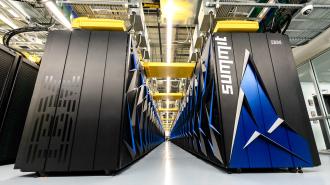Using the world’s fastest supercomputer, researchers have identified 77 drug candidates that show promise in the fight against COVID-19, the respiratory illness sweeping the globe. It’s only the first step — and it’s certainly not a cure — but it may point scientists researching new treatments in the right direction.
In 2018, the U.S. Department of Energy’s Oak Ridge National Laboratory (ORNL) launched Summit, a supercomputer capable of performing 200,000 trillion calculations per second — that makes it about a million times more powerful than a high-end laptop.
As COVID-19 began to spread across the globe, a pair of researchers from ORNL decided to put Summit’s processing power to use, hunting down promising drug candidates to stop the illness. They’ve now published the results of their efforts on the pre-print server ChemRxiv.
Supercomputer Simulations
Like all viruses, the coronavirus at the center of the COVID-19 outbreak — SARS-CoV-2 — uses a “spike protein” to access and infect its host’s cells.
Researchers Jeremy C. Smith and Micholas Smith created a model of SARS-CoV-2’s spike protein, using early studies of the coronavirus’s structure as their guide.
“Summit was needed to rapidly get the simulation results we needed.”
Jeremy C. Smith
They then used the Summit supercomputer to perform simulations of how different compounds would attach to the spike protein. Their goal was to identify any that might bind to SARS-CoV-2 in a way that would impede its ability to enter and infect a human cell.
The team chose to focus on 8,000 compounds that it believed could be rapidly deployed in the fight against COVID-19. And based on the Summit simulations of those compounds, the researchers believe 77 are worth further study.
Spike Protein, Take Two
According to Jeremy Smith, he and his colleague could have identified the potential drug candidates for COVID-19 without a supercomputer, but not nearly as quickly.
“Summit was needed to rapidly get the simulation results we needed,” he said in a news release. “It took us a day or two whereas it would have taken months on a normal computer.”
The researchers will be putting the time they saved to good use, too.
Not long after they created their model, researchers at the University of Texas at Austin released their own atomic-scale 3D map of the coronavirus’s spike protein. The ORNL team now plans to run its supercomputer simulations again, using that more-detailed protein model.
That might affect the compounds they recommend for further study, but identifying promising compounds is still just one step along the path to beating COVID-19.
“Our results don’t mean that we have found a cure or treatment for the Wuhan coronavirus,” Jeremy Smith said. “We are very hopeful, though, that our computational findings will both inform future studies and provide a framework that experimentalists will use to further investigate these compounds.”
“Only then will we know whether any of them exhibit the characteristics needed to mitigate this virus,” he concluded.
